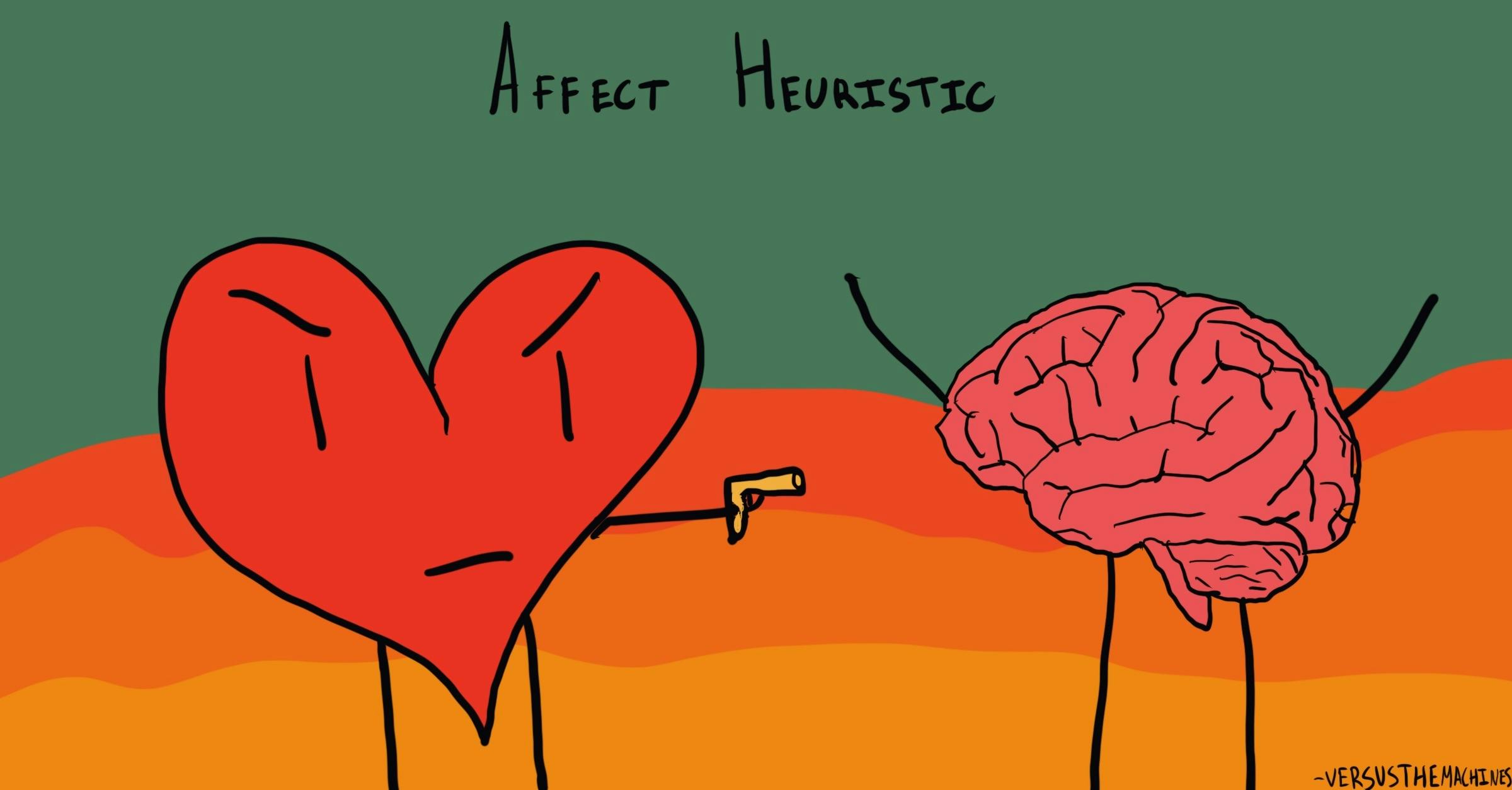Why do we rely on our current emotions when making quick decisions?
Affect Heuristic
, explainedWhat is the Affect Heuristic?
The affect heuristic describes how we often rely on our emotions, rather than concrete information, when making decisions. This allows us to reach a conclusion quickly and easily, but can also distort our thinking and lead us to make suboptimal choices.

Affect Heuristic
Where this bias occurs
Your friend Casey has been invited to audition for a play being put on by a prestigious theater company. Casey has always had a passion for acting, and this would be a big opportunity for them. However, Casey received the invitation the same day they learned they failed their driving test. Not only was Casey angry and upset, but their self-esteem took a serious hit. As a result, they impulsively told the theater company that they were not interested in auditioning for the play, assuming they wouldn’t get the part anyways.
Casey’s negative emotions after failing their driving test led them to overestimate the risks of auditioning for the play. They felt that there was a good chance that they would fail again. This is illogical, as Casey’s driving ability is completely independent of their acting ability. As a result, they are missing out on what could have been a great experience for them. This scenario exemplifies the affect heuristic, demonstrating how we sometimes rely on our emotions instead of logic when making decisions.
Debias Your Organization
Most of us work & live in environments that aren’t optimized for solid decision-making. We work with organizations of all kinds to identify sources of cognitive bias & develop tailored solutions.
Individual effects
The affect heuristic can influence any decision but specifically comes into play in situations where there is significant time pressure.1 This means that if we need to make an important choice quickly, resorting to this heuristic may lead us in the wrong direction.
Furthermore, the affect heuristic can drastically limit our options. For instance, we may be unwilling to put ourselves out there because of some gut feeling that we won’t succeed. This could prevent us from stepping out of our comfort zone at times and doing so could lead to great success.

Systemic effects
The affect heuristic can actually inspire positive changes within society, especially through public health campaigns. These campaigns often use fear appeals to decrease certain unhealthy behaviors by sharing statistics, information, and images that make people scared of that behavior. The efficacy of fear appeals has been hotly debated over the years but, in theory, this is a potentially beneficial application of the affect heuristic.
On the other hand, the affect heuristic can also result in systemic challenges. If someone in a leadership position has an important decision to make, they may come to a conclusion solely based on their emotions. This is more likely if they are tired or under time pressure, as we rely on heuristics more when we do not have sufficient mental resources to make an effortful, well-reasoned decision. In this scenario, one person’s emotions can negatively impact the lives of many.
How it affects product
User interface can significantly influence our level of emotional engagement when using a digital device. If we find the design aesthetically appealing, it will encourage us to continue interacting with that product. Meanwhile, if we find the design jarring or unappealing, the resulting negative emotions might deter us from remaining on the interface much longer.
For example, when Twitter updated its logo to “X” in July of 2023, the abrupt switch didn’t resonate well with most users. In fact, it spurred public outrage, with many leaving the app. This anecdote is a great reminder to thoroughly review customer reactions within a target clientele before making major interface changes. Otherwise, their negative emotions might make them shy away from your product.
The affect heuristic and AI
As discussed previously, we are more likely to fall victim to the affect heuristic when we are short on time or energy. This means that our emotional vulnerability may play a huge role in how effectively we use AI software.
Let’s say you’re cramming to finish a research paper due at midnight. Overwhelmed by stress, you impulsively resort to ChatGPT to write a couple of paragraphs from you. Without checking them over, you copy and paste them into your document and turn the paper in, minutes before the deadline. Unfortunately, you failed the assignment; the information in those paragraphs was incorrect, and your professor suspected that you plagiarized them.
Meanwhile, if you had consulted ChatGPT a week in advance to brainstorm ideas and fact-check your resources, you could have incorporated this resource into your outline in a calm and collected manner. This would have paid off in a better grade and a final product you were proud of calling your own. With the affect heuristic in mind, we should view AI as a continual tool rather than an emergency resource to make the best decisions possible.
Why it happens
Dual process theory posits that we have two cognitive systems: one that is automatic and one that is effortful. Research suggests that the affect heuristic results from the former.2 In addition, the affect heuristic occurs because our affective state (in other words, our current emotions) alters our perception of the risks and benefits of a particular outcome.
Dual system thinking
Dual process theory is a foundational theory in cognitive psychology. It suggests that humans have two distinct cognitive systems for decision-making. The first, System 1, is fast, effortless, automatic, and emotional, while the second, System 2, is slow, effortful, deliberate, and logical.
There is a common misconception that System 1, rooted in emotion, is maladaptive and always leads to poor decision-making, while System 2, rooted in reason, is superior in every way. However, as Daniel Kahneman pointed out in his book, Thinking, Fast and Slow, both systems have pros and cons.3 System 1 thinking is beneficial when there is no time to deliberate because we must make an immediate decision. This kind of automatic thinking allows us to make the instinctive choice to hit the brakes when someone cuts us off on the highway or to jump into action to perform the Heimlich maneuver on someone who is choking. In an emergency, there is no time to sit around and make a slow, effortful decision with System 2.
To no surprise, the affect heuristic results from System 1 thinking. Instead of making a well-reasoned decision, we make a quick choice based on our emotional state. When we need to make a snap judgment, System 1 can be to our benefit. But when we should be taking the time to weigh our options, the affect heuristic may lead us to make different decisions than we would have made otherwise.
Risks and benefits
Another factor contributing to the affect heuristic is our perception of the risks and benefits of making a certain decision. Our mood state influences risk assessment, which in turn influences our behavior.
When we experience positive affect, we tend to perceive an option as being low risk and having high potential benefits. In contrast, when we experience negative affect, we perceive the option as being high risk and having few potential benefits.4 Naturally, if we feel that selecting a certain option will lead to a big payoff with little chance of negative consequences, we feel more inclined to make a decision in its favor. Along the same vein of reasoning, if we feel that choosing a certain option is extremely risky and believe that we will not get much out of it, we are unlikely to select it. As such, the impact our emotions have on our perceived risks and benefits of a given outcome can significantly affect our decision-making.
Why it is important
No matter what, we’re faced with decisions every day. Granted, some are more important than others, but even seemingly small decisions can have significant consequences. To ensure that we’re making the best choices possible, we need to be aware of the different heuristics and biases that can influence our decision-making. This way, we can learn how to avoid them and make more conscious decisions where it counts.
How to avoid it
By simply being aware that our emotions can impact our decisions, we can begin learning how to avoid the affect heuristic. We should not rely exclusively on System 1 thinking when faced with big decisions. By taking the time to think logically about the choice we have to make and considering all possible options, we prevent ourselves from taking mental shortcuts to reach a conclusion.
Furthermore, being aware of one’s emotional state is useful for avoiding the affect heuristic. Suppose we can recognize that we are feeling a certain way, whether that be happy, sad, or angry. In that case, we can acknowledge that our emotions have the potential to affect our decision-making and, in doing so, remind ourselves to activate our System 2 thinking.
If anything, it is a good idea to put off making an important decision if we are feeling particularly emotional, whether that means very excited or sad. This will help to ensure that extreme emotions do not impact our choice.
How it all started
In 1980, social psychologist Robert B. Zajonc highlighted the importance of emotions in decision-making in “Feeling and thinking: Preferences Need No Inferences”.5 He suggested that all perception has an affective component. For example, “We do not just see ‘a house’: we see a handsome house, an ugly house, or a pretentious house.”(p.154). Furthermore, Zajonc demonstrated that our first response upon perceiving a new stimulus is often emotional. This was contrary to the accepted belief at the time that affective states only arise from cognitive and perceptual processes. However, Zajonc argued that affect is the only constant. When we perceive a stimulus, we will always feel some emotion towards it, but our cognitive activity is subject to vary.
The theory that we can feel emotions before or even without cognitive activity opened up the floor to the discussion of how affective states influence decision-making. In 2000, Paul Slovic et al. published a paper titled “The affect heuristic”6, in which they introduced the heuristic. Additionally, they presented experimental findings to demonstrate how our emotions influence our evaluation of the risks and benefits of a given behavior.
Example 1 – Fear appeals
Public health campaigns use the affect heuristic to encourage people to practice healthy behaviors and avoid maladaptive ones. They do so through fear appeals, which serve to scare the population by presenting the worst-case scenario of continuing to partake in certain behaviors.
A classic example of this is anti-smoking campaigns, which use pictures to deter people from smoking. Some countries display images of the teeth and lungs of longtime smokers on the sides of cigarette packages. Additionally, such campaigns stress the severity of the consequences of smoking using statistics, such as the increased risk of cancer, stroke, and gum disease.
David Hammond and Geoffery T. Fong explored the efficacy of fear appeals on cigarette packages in their 2004 paper, “Graphic Canadian Cigarette Warning Labels and Adverse Outcomes: Evidence from Canadian Smokers”.7 They found that of the 616 Canadian smokers surveyed, 20% reported smoking less due to the warning labels. The greater negative affect that smokers felt, which were most commonly fear and disgust, the more likely they were to attempt quitting smoking, or at least cut back on their number of cigarettes.
Negative emotions pushed people to reduce their smoking, highlighting how our emotions can also drive proactive behaviors. In this case, we see how the affect heuristic is not always irrational, but can actually lead to logical decisions. However, it may help that fear appeals do not promote random choices but are strategically designed to help us to do the right thing.
Example 2 – Interpreting statistics
We think of statistics as cold, hard facts, but our interpretations of them are not always objective. The emotions we feel when learning certain statistics can influence the inferences we make from them. Moreover, our emotions can be manipulated by how the statistics are presented.
In a study conducted by Slovic et al. in 2000, a group of psychiatrists and forensic psychologists evaluated the likelihood that a mentally ill patient would act violently within six months of being discharged from the hospital. All participants were provided with statistical evidence to inform their decision. For half of the participants, this information was presented in terms of relative frequency: “20 out of every 100 patients similar to Mr. Jones are estimated to commit an act of violence”. The other half were given the statistics framed in terms of equivalent frequency: “patients similar to Mr. Jones are estimated to have a 20% chance of committing an act of violence.”
In the relative frequency group, 41% of participants said the patient should not be discharged while only 21% of participants in the equivalent frequency group said he should not be discharged. In both cases, the same numbers were presented; they differed only in the way they were presented. The researchers hypothesized that this was because the low probability of 20% elicited images of a single individual who is unlikely to behave violently. This benign image would not cause any of the participants’ moods to deviate from baseline. On the other hand, the equivalent frequency brought forth images of several aggressive individuals who are comparable to the patient in question. Imagining people committing violent acts induced negative mood, eliciting emotions such as fear, which made the participants less willing to discharge the patient.8
Even though presenting statistics in varying ways does not change the objective values, it can influence our affective responses. Our emotions may consequentially impact the way we interpret the statistics, influencing our decision-making. If Slovic et al.’s study had been a real-world example, the framing of statistics would have actually impacted whether or not a patient was discharged.
Summary
What it is
The affect heuristic refers to how we can make judgments and decisions more efficiently—although not always more accurately—when relying on our emotions.
Why it happens
We can explain the affect heuristic using dual process theory, which states that we have two distinct cognitive systems for decision making, one that is automatic (System 1) and one that is effortful (System 2). The affect heuristic is a product of the automatic system, arising from our affective state. Our emotions can also alter our perception of the risks and benefits of a certain outcome, swaying how likely we are to choose it.
Example 1 - Fear appeals
Public health campaigns have used the affect heuristic to deter people from engaging in unhealthy behavior by sharing scary or disturbing information. Anti-smoking campaigns, for example, intentionally place information about the consequences of smoking and pictures of diseased gums and lungs on cigarette packages. A survey found that the more negative emotions people felt in response to these warning labels, the more likely they were to cut back on smoking or even quit altogether.
Example 2 - Interpreting statistics
Statistics presenting the probability of a certain event occurring have the ability to elicit emotional responses from us. These responses can be manipulated by the way the information is framed.
For example, clinicians in a study were less willing to discharge a psychiatric patient when told that 20 out of every 100 individuals like him committed a violent act in the six months after being discharged. This is because the equivalent frequency framing forced them to imagine several people committing violent acts, increasing their fear the patient would do the same.
How to avoid it
Being aware of the affect heuristic can help us remind ourselves to take our time making important decisions. This way, we can come to a conclusion using sound reasoning, instead of making an impulsive choice based on our emotions.
Related TDL articles
How priming affected donation amounts by 96%
Not only can the emotional framing of statistics discourage maladaptive behaviors—it can also encourage proactive behaviors. In our intervention designed to promote charitable giving, we discovered that priming participants with an emotional stimulus made them 96% more likely to donate money. Meanwhile, analytical priming barely influenced donations at all. Read this article to find out more about how the affect heuristic can push us toward supporting important causes.
Nudging Consumers Towards Big-Picture Thinking
Making financial decisions in a highly emotional state can cause us to spend our money in ineffective or even hazardous ways. However, in this article, John Laurence shares how emotionally engaging consumers by using first-person perspectives when making financial decisions can encourage them to invest in their future selves.

